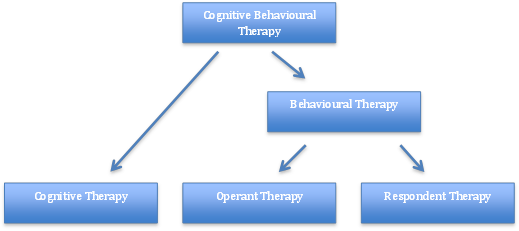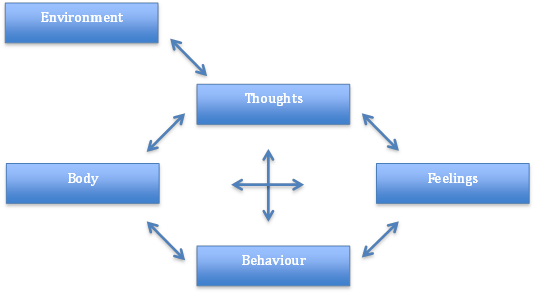Cognitive Behavioural Therapy: Difference between revisions
Kim Jackson (talk | contribs) m (formatting) |
Kim Jackson (talk | contribs) (Grammar and categorisation) |
||
| Line 24: | Line 24: | ||
Aaron Beck and Christine Padesky first recognised this CBT model in the 1970s <ref name="Beck 1976">Beck, A.T., 1976. Cognitive Therapy and the Emotional Disorders. New York: International Universities Press</ref>. | Aaron Beck and Christine Padesky first recognised this CBT model in the 1970s <ref name="Beck 1976">Beck, A.T., 1976. Cognitive Therapy and the Emotional Disorders. New York: International Universities Press</ref>. | ||
=== How it is | === How it is Used === | ||
Negative thoughts (e.g., "My back pain is uncontrollable" --> Negative feelings (e.g., depression, anger) and maladaptive health behaviours (e.g., skipping treatment sessions) --> Reinforcing negative cycle. | Negative thoughts (e.g., "My back pain is uncontrollable" --> Negative feelings (e.g., depression, anger) and maladaptive health behaviours (e.g., skipping treatment sessions) --> Reinforcing negative cycle. | ||
If one negative thought can be changed or better understood, then it can break down this negative cycle. This can be addressed through education and methods to manage symptoms <ref name="Beck 1976" />. | If one negative thought can be changed or better understood, then it can break down this negative cycle. This can be addressed through education and methods to manage symptoms <ref name="Beck 1976" />. | ||
== References == | == References == | ||
<references /> | |||
[[Category:Occupational Health]] | [[Category:Occupational Health]] | ||
[[Category:Mental Health]] | [[Category:Mental Health]] | ||
[[Category:Interventions]] | |||
Revision as of 17:36, 13 October 2019
Original Editor - Rachael Lowe
Top Contributors - Scott Buxton, Kim Jackson, Anthonia Abraham, Vidya Acharya, Patti Cavaleri, Shaimaa Eldib, Rachael Lowe, Mariam Hashem, WikiSysop and Claire Knott
What is Cognitive Behavioural Therapy?[edit | edit source]
Cognitive Behavioural Therapy (CBT) is a method that can help manage problems by changing the way patients would think and behave. It is not designed to remove any problems but help manage them in a positive manner [1] [2].
Behaviour therapy (BT) was developed in the 1950’s independently in three countries: South Africa, USA and England [3]. It was further developed to Cognitive Therapy (CT) in the 1970’s by Dr Aaron Beck with its main application on people with depression, anxiety and eating disorders [1] [4]. However, the main evidence today focuses on CBT, after the merging of BT and CT in the late 80’s [5].
Fig.2 - Breakdown of CBT theory
The Cognitive Behavioural Therapy Model[edit | edit source]
Fig.3 - Factors involved within the Cognitive Behavioural Therapy Model
Aaron Beck and Christine Padesky first recognised this CBT model in the 1970s [6].
How it is Used[edit | edit source]
Negative thoughts (e.g., "My back pain is uncontrollable" --> Negative feelings (e.g., depression, anger) and maladaptive health behaviours (e.g., skipping treatment sessions) --> Reinforcing negative cycle.
If one negative thought can be changed or better understood, then it can break down this negative cycle. This can be addressed through education and methods to manage symptoms [6].
References[edit | edit source]
- ↑ 1.0 1.1 Beck, J., 1995. Cognitive Therapy: Basics and Beyond. Guildford Press: New York
- ↑ NHS Choices, 2012. Cognitive behavioural therapy. [online] Available at:http://www.nhs.uk/conditions/cognitive-behavioural-therapy/Pages/Introduction.aspx[Accessed 8th Jan 2014]
- ↑ Öst, L.G., 2008. Efficacy of the third wave of behavioral therapies: a systematic review and meta-analysis. Behaviour research and therapy, 46(3): 296–321
- ↑ Hayes, S.C., 2004. Acceptance and commitment therapy, relational frame theory, and the third wave of behavioral and cognitive therapies. Behavior Therapy, 35: 639–665
- ↑ Roth, A., Fonagy, P. “What works for whom? A critical review of psychotherapy research”. 2nd ed. Guilford Press: New York 2005
- ↑ 6.0 6.1 Beck, A.T., 1976. Cognitive Therapy and the Emotional Disorders. New York: International Universities Press








